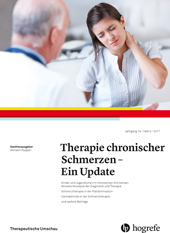Placeboanalgesie und Nocebohyperalgesie – Mechanismen und klinische Nutzung
Abstract
Zusammenfassung. Placebophänomene und seine negative Kehrseite – sog. Nocebophänomene – sind aktive und objektivierbare psychoneurobiologische Reaktionen des Organismus, die als solche Einfluss auf den Heilungsprozess haben und daher klinisch relevant sind. Sie sind dem therapeutischen Gesamtbehandlungskontext zuzuordnen und können dadurch sowohl bei Schein- als auch bei Verumbehandlungen auftreten. Psychologische Erklärungsansätze zeigen, dass diese auf bewussten und unbewussten Lernprozessen basieren und das Ausmass der Placebo- und Noceboreaktion primär durch Erwartungshaltungen, die Qualität der Arzt-Patient-Kommunikation und Konditionierung bestimmt wird. Neurobiologisch werden diese Prozesse über unterschiedliche Signalsysteme vermittelt, die verschiedene Arten von Placeboreaktionen bedingen. Am besten erforscht sind diese bisher bei der Schmerzmodulation in Form der Placeboanalgesie bei positiver bzw. der Nocebohyperalgesie bei negativer Erwartung. Die Erkenntnisse der Placebo- und Noceboforschung können dafür genutzt werden, die mit dem Behandlungskontext assoziierten psychosozialen Komponenten besser und gezielter in der alltäglichen medizinischen Praxis einzusetzen, um damit bereits wirksame Verumbehandlungen zum Wohle des Patienten weiter zu optimieren. Durch die Maximierung von Placebo- und Minimierung von Nocebokomponenten kann die Wirksamkeit und Verträglichkeit von pharmakologischen Substanzen ohne Täuschung gesteigert, unerwünschte Nebenwirkungen reduziert, die Compliance erhöht und Kosten gespart werden. Im Artikel werden verschiedene praxisrelevante Ansätze und psychologische Strategien für die systematische Nutzung dieser Mechanismen zur Optimierung von Schmerztherapien vorgestellt.
Abstract. Placebo phenomena and its negative counterpart – so-called nocebo phenomena – are highly active and measurable psychoneurobiological reactions of the mind-body-system. These reactions can modulate positive (placebo) and negative (nocebo) psychobiological and behavioral changes essential to healing processes and well-being and are therefore clinical relevant. These conscious und subconscious learning processes are attributable to the psychosocial context around the patient in which the treatment is delivered and can occur in sham as well as in verum treatments. Many different placebo responses exist and are mediated by diverse psychological mechanisms such as expectation, the quality of the doctor-patient communication and conditioning. Focusing on pain modulation, neuropsychological aspects of placebo analgesia and nocebo hyperalgesia will be reviewed. An improved understanding of placebo and nocebo responses will build the basis for making systematic supportive use of the psychosocial ingredients associated with the context to optimize effective treatments for the patient’s benefit. By maximizing placebo components and minimizing nocebo components, the pharmacological efficacy and tolerability can be non-deceptively increased, compliance enhanced and side effects and costs reduced. Several practical psychological approaches will be proposed to exploit these mechanisms in improving pain interventions.



